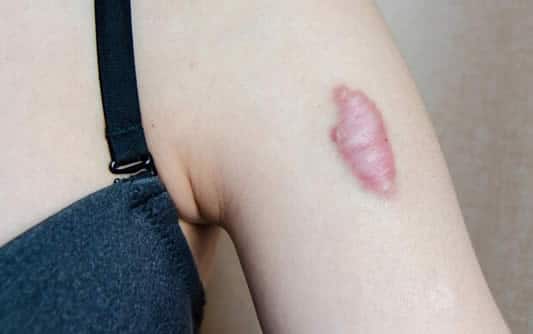Anything that causes skin to scar can cause a keloid.
- Body piercing (especially ear piercing)
- Bout with acne or chickenpox (usually developing on the face, chest, or back)
- Burn
- Cut, scrape, or bug bite
- Deep wound like a puncture wound
- Skin disease that causes inflammation like folliculitis
- Tattoo
- Wound caused by surgery, a procedure, or an injection
- Some people get a keloid when they shave their beard area.
- It’s also possible for a keloid to appear on uninjured skin. This keloid is called a “spontaneous keloid.”
Spontaneous keloids are rare, so there are only a few known cases. Findings from studies suggest that these keloids may occur when:
- The skin injury is so minor that the person doesn’t notice it.
- A disease causes intense inflammation inside the body.
- Certain medication is taken.
Exactly what happens inside the body to cause keloids isn’t fully understood. Researchers know that the body produces more collagen than it needs to heal the injured skin. That’s why the keloid scar grows bigger than the wound that caused it.
To understand all that happens inside the body, dermatologists continue to study keloids.
Does melanin cause keloids?
Melanin is the pigment that gives our skin, hair, and eyes their color. The more melanin your body produces, the darker your skin, hair, and eyes.
Researchers have been studying what role, if any, melanin plays in causing keloids because:
- Black people have more melanin than other races, and they are more likely to develop keloids than white people.
- When we injure our skin, the body produces cells that make pigment (melanocytes). This means there’s more melanin in the injured area.
- Keloids are more likely to develop on areas of the body that have more melanocytes (cells that make pigment). For example, a keloid is more likely to form on the chest than the palm of the hand.
These facts certainly suggest that melanin might play a role in causing keloids.
Some people are more likely to get keloids
In the United States, Black people between the ages of 10 and 30 have the greatest risk of developing a keloid.
Researchers continue to study keloids to find out what causes them. Knowing exactly what causes this type of scar could lead to better treatment and more effective ways to prevent keloids.
What increases the risk of developing keloids?
While studying what causes keloids, dermatologists learned that certain people seem more likely to develop these scars. Here’s what seems to increase the risk:
- African, Asian, or Latin-American descent: In the United States, keloids are more common in Black and Latin Americans than people with lighter skin tones. Whereas, in Asia, ethnic Chinese have the highest risk of developing keloids.
- Family history of keloids: About one-third of people who get keloids have a first-degree blood relative (mother, father, sister, brother, or child) who gets keloids. This is most common in people of African or Asian descent.
- Age (10 and 30 years old): This is the peak time to develop keloids. Most people begin seeing keloids in their 20s. However, a keloid can develop at any time. Infants get keloids. People 70 years of age or older develop keloids.
- Pregnancy: The hormonal changes that occur during pregnancy increase the risk of developing a keloid.
If you have keloids, contact our office to schedule a consultation to learn about your options.

